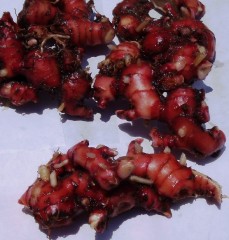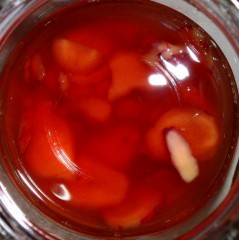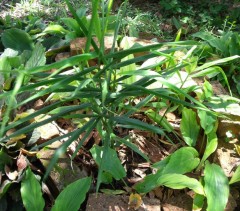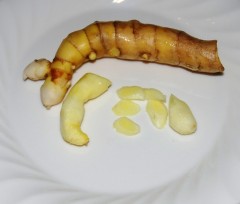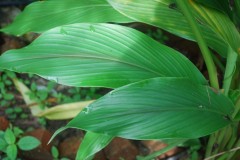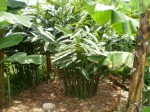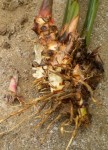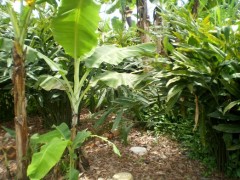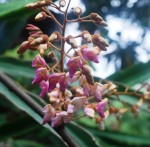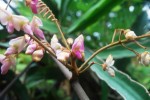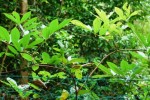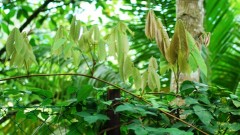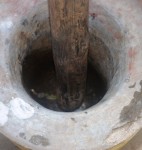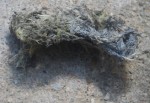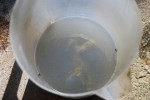Jul 15, 2010
Fungal and Bacterial Preventive, Naturally.
This is what we use as a preventive, especially during rainy weather against bacterial and fungal attacks on our plants (leaves and stems, not roots);
Take 500 grams gelenggang ( cassia alata ) leaves and 400 grams lengkuas rhizomes ( alpinia galanga ) and pound them.


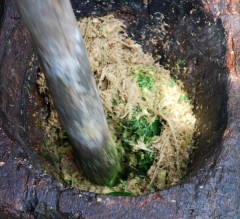
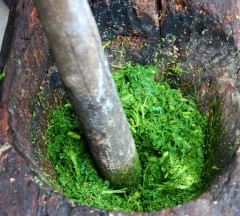

We find the spray effective as a prevention against most fungal and bacterial infections on stems and leaves. Spray regularly but lightly (sparingly) twice a week. During bad weather or where there are early signs of disease, spray once a day sparingly (lightly) until disease is arrested. It is not effective if disease is well on its way.
18:58 Posted in Useful Plants | Permalink | Comments (0) | Tags: anti-bacterial plants, anti-fungal plants, alpinia galanga, cassia alata, gelenggang, lengkuas, useful plants
Apr 11, 2010
Useful Plants At The Farm - Red Ginger
Red Ginger (zingiber officinale var rubrum) has a sharper taste and is more aromatic than normal ginger. Though cultivated, it can also be found growing wild in the jungles.
If you are a lover of the taste and aroma of ginger in cooking, then the red ginger is something you must try.
Here's red ginger in apple cider vinegar. The red color seeps into the vinegar and is preserved by the acid. Fresh red ginger exposed to light will fade within hours.
The red ginger has excellent anti-inflammatory properties and is especially effective for those with chronic inflammatory problems such as arthritis, carpal tunnel, etc. Drinking just a finger on alternate days will do wonders for your aches and pains. Here's a study: http://www.ncbi.nlm.nih.gov/pubmed/20136450
At the farm it is part of a very important tonic which we feed to the chickens when they are doing poorly. The ginger also has strong anti-bacterial activity.
The red ginger is very effective in bringing down high blood pressure. Take two thumbs, blend with some sugar and then heat it up to just below boiling point for a minute or two. Sieve, and then sip slowly like a tea. Relax, after an hour measure your BP. You will be surprised!
Note that to 'cure' HBP, a holistic approach must be taken. We are not advocating red ginger as a 'cure' for HBP. It should be part of a total approach and you should consult your health-care provider before embarking on any alternative medical treatment.
16:59 Posted in Useful Plants | Permalink | Comments (0) | Tags: ginger, zingiber, halia bara, halia merah, zingiber officinale var rubrum, red ginger;
Jan 10, 2010
Useful Plants At The Farm- Curcuma Mangga
Curcuma mangga is also known as white turmeric. It tastes like a mango, hence the name 'mangga'.
The rhizome with skin and without.
Researchers have found anti-tumour activities from extracts of the rhizomes. On a personal basis, we have found it to have strong anti-inflammatory effect and we have incorporated it into our diet on a regular basis, either as a ulam or salad, or as a drink.
The plant can reach about 5 feet high.
Close up of the leaf
At the farm, we gather the soil around the roots and rhizome and make a foliar spray to combat fungal infections on plants.
Take one part soil, one part molasses, and 4 parts water and aerate vigorously for 10 hours.
Use twice a week on plants with signs of fungal attacks.
19:35 Posted in Useful Plants | Permalink | Comments (11) | Tags: temu pauh, kunyit putih, curcuma mangga, actinomycetes, anti fungal, anti tumour
Apr 10, 2009
Useful Plants At The Farm- Galangal or Alpinia Galanga / Greater Galanga
The Greater Galanga or lengkuas is a ginger originally from Malaysia and Indonesia. It is used in Thai, Malay, Nyonya and Indonesian cuisine.
It is active against gram-positive and gram-negative bacteria.
In our farm, we have found it to be effective against mycoplasma sp. infection in the chickens. In combination with garlic and at the appropriate dosage it is effective against chronic infections.
We now use lengkuas as a weekly preventive for the chickens
At our farm, we grow the lengkuas wild in our Food Forest. It requires no maintenance and provides free medicine for our animals and even our workers.
Here’s more information about lengkuas:
http://en.wikipedia.org/wiki/Greater_galangal
You can learn a saying or two about lengkuas here:
17:30 Posted in Useful Plants | Permalink | Comments (2) | Tags: galangal, alpinia galanga, greater galanga, lengkuas, lankwas, laos, food forest, permaculture
Apr 04, 2009
Useful Plants At The Farm- Derris elliptica or Tuba
Tuba root has long been used by the ‘Orang Asli’ to fish, as it is a piscicide.
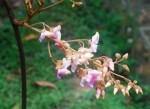
As we can see from the pictures, the plant has arresting flowers.
It is a creeping and climbing vine.
It is a wasteful method of fishing as all fish, big or small are wiped out within minutes. Thankfully, very few ‘Orang Asli’ are using tuba roots nowadays and in fact, some do not even know how to identify it.
The root of the tuba.
In the farm we grow it for use as an insecticide. It is the only local plant that we know of, that’s truely insecticidal. The rest are repellents. For many years, organic standards permitted the use of rotenone, the active ingredient in tuba root against insects. That has now been withdrawn.
Pounding the root.
We do not use tuba on vegetables or fruits, but on roots and trunks of non-fruiting trees and ornamentals that are attacked by tough borers etc. The withdrawal of its use in organic farms is because of concern over its safety after scientists injected the active ingredient, rotenone, into the blood stream of rats and which resulted in Parkinson’s-like symptoms in the rats.
The pounded root will be squeezed in water to make an aqueous extract of the active ingredient, rotenone.
The milky aqueous extract ready for use.
Quote from Wikipedia, “In 2000 it was reported that injecting rotenone into rats causes symptoms of Parkinson's disease to develop. Rotenone was continuously applied over a period of five weeks, mixed with DMSO and PEG to enhance tissue penetration, and injected into the jugular vein.[12] “ . Citation [12] here refers to : Caboni P, Sherer T, Zhang N, Taylor G, Na H, Greenamyre J, Casida J (2004). "Rotenone, deguelin, their metabolites, and the rat model of Parkinson's disease". Chem Res Toxicol 17 (11): 1540–8.
One would think that would be expected injecting toxic stuff into the bloodstream. Anyway, as an organic farmer, it is better to be on the safe side and cease from using tuba on edibles. The tuba extract does not remain in the environment and is totally detoxifed in 6 to 7 days, being degraded by sunlight.
In the farm, though rarely used, it is nonetheless a useful plant to have.
18:45 Posted in Useful Plants | Permalink | Comments (5) | Tags: derris, tuba, fish poison, piscicide, organic insecticide, tuba root, akar tuba
Feb 28, 2009
'Miraculous' Plants at the Farm

The young green unripe limau nipis,(Citrus Aurantifolia), or key lime, is the most aromatic fruit you will ever taste. We kid you not!!
But you need to first eat one of the berries from this bush - the Miracle Berry bush. 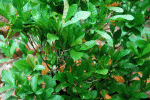 Otherwise the extreme sourness of the limau will shut down all your other senses and you will not be able to experience the aroma. After you chew on the berry,
Otherwise the extreme sourness of the limau will shut down all your other senses and you will not be able to experience the aroma. After you chew on the berry, 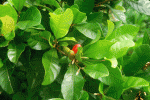 the sourness of the limau is ‘smothered’ by sweetness. The limau becomes so delicious you want to finish off the whole fruit and you have to remind yourself what’s happening to avoid a major tummy upset later on.
the sourness of the limau is ‘smothered’ by sweetness. The limau becomes so delicious you want to finish off the whole fruit and you have to remind yourself what’s happening to avoid a major tummy upset later on.
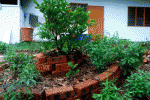
The Miracle Berry Bush
The miracle berry is a bush from West Africa (Synsepalum dulcificum or Richadella dulcifica).
The active ingredient is called Miraculin, which in itself is not sweet, but the tongue, once exposed to miraculin, perceives sour foods such as citrus as sweet for up to a couple of hours afterwards.
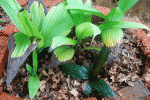 If you chew on the fruit of the lemba or curculi latifolia, plain water and any sour drink will taste sweet. The lemba is found in wet areas of the jungle and we can find them in the jungle next to our farm. The leaves can be used to make ropes and for wrapping things.
If you chew on the fruit of the lemba or curculi latifolia, plain water and any sour drink will taste sweet. The lemba is found in wet areas of the jungle and we can find them in the jungle next to our farm. The leaves can be used to make ropes and for wrapping things. 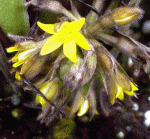
There's a patent in the USA (Patent 5378489 ) for the use of the active ingredient, curculin, as a form of sweetener by a team of Japanese scientists.
Don't you think we Malaysians should be ashamed of ourselves for not recognising the value of plants that's growing literally right outside our doorsteps?
23:23 Posted in Useful Plants | Permalink | Comments (0) | Tags: miracle berry, lemba, curculin, miraculin, curculigo, natural sweeteners
Feb 27, 2009
Useful Plants at the Farm - Gliricidia Sepium
This is a plant from Central America, now endemic in Malaysia. It is an inconspicuous and not particularly pretty small tree. You will see it by the road side growing wild. It is known as 'pokok pagar' locally. In our farm, it serves multiple functions.
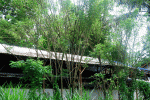
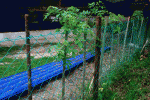
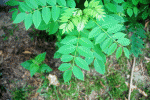
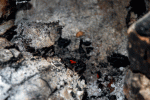
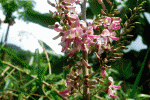


18:23 Posted in Useful Plants | Permalink | Comments (2) | Tags: medicinal plants, herbal plants, fungicide, animal feed
Useful Plants at the Farm - Cassia Alata
You have most probably noticed this plant at the roadside, especially near earth-drains and low-lying wet areas. It is called Cassia Alata or Gelenggang.
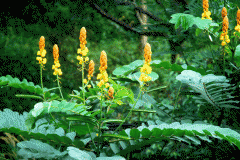

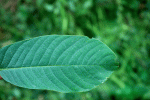
17:32 Posted in Useful Plants | Permalink | Comments (1) | Tags: medicinal plants, herbal plants, fungicide, cassia alata, gelenggang








